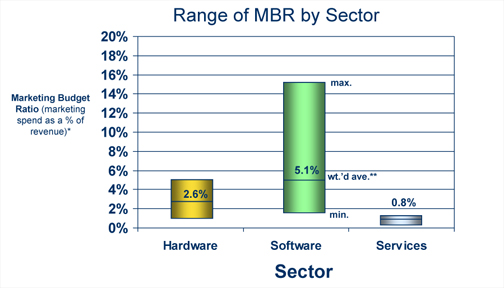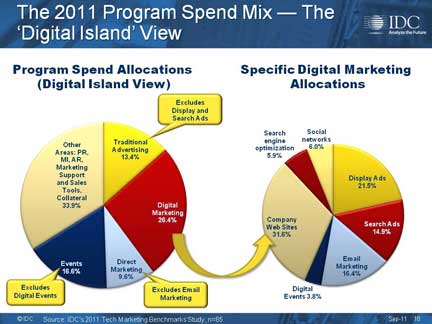Marketing Mix Budget Allocation
What to Spend Where
As a CMO, one of the questions I am asked most frequently is how much should I be spending on marketing? Of course, the answer varies greatly. Methods for determining marketing budgets include analyzing business plan objectives, past marketing budgets, and competitors' marketing expenditures. However, the most common method is determining marketing budgets as a percentage of sales.
Depending on industry, competitive position, size and age of the company, products, services, the market, and a host of other considerations, B2B marketing spending may be anywhere from 1 to 10% or more of sales, depending on your goals and objectives.

IDC CMO Advisory Service 2009 Tech Mktg. Investment Planner (c) 2008 IDC
Ideal vs. Real
Not surprisingly, there is no one-size-fits-all answer. Here at CMO, after factoring in your competitive position, sales forecasts and industry/economic indicators, we typically offer three budget ranges: ideal world, bare minimum, and real-world/best ROI. After all, marketing is an investment. You can invest high risk/high growth, cautious/lower return, or a balanced mix of the two.
Ultimately, the marketing budget must reflect your organization's market position and personality. If there is an emerging niche and you hold a competitive advantage with a limited window of opportunity, more aggressive strategies and tactics may be merited. Conversely, if you have a mature product line and flat growth forecasts, a steady, sustained "brand loyalty" strategy may be sufficient (while your R&D investments focus on next generations, product line extensions, and new products and services).
Of equal importance - and the second most asked question - is budget allocation. "What percentage of my marketing budget should I spend on what?" Print vs. online vs. trade shows vs. direct mail vs. web optimization, etc. There are numerous studies detailing the average spending within the marketing mix. (See below. Click Image to enlarge.)
IDC CMO Advisory Service 2009 Tech Mktg. Investment Planner (c) 2011 IDC
In fact, how much you spend is not nearly as important as how well you spend it. Again, this requires a balanced approach. Integrated marketing and media synchronization (orchestrating the marketing mix as a whole) amplifies the effectiveness of each individual component. An integrated campaign combining online and print advertising, a campaign-specific landing page, press release or product announcement, trade show presence, coordinated telemarketing/sales script, and fulfillment piece will amplify and accelerate results far beyond any individual effort.
The wide variety of tools available to today's marketer presents both incredible opportunity and significant challenge. Some tools may be capable of multiple jobs, but each has its own strength. (A pair of pliers and a wrench may both turn a nut, but size, location and torque may suit one over the other.) The key is to ensure that your toolbox contains the right mix of the essential tools, with perhaps a few specialty tools for your unique marketplace.
Back to the original question, it's not how much, it's how well. Our clients often battle competitors with much deeper pockets. Integrated marketing and media synchronization helps you play big for your size. Sound strategy, creative inspiration and meticulous execution helps ensure the right people get the right message at the right time. And, measuring results and continuous optimization of your marketing program delivers a sustainable, ROI-based marketing program that generates results empowering your organization to Achieve More(tm).
For a no-obligation marketing check-up, call 703-591-0100 or send us an email.





